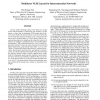Free Online Productivity Tools
i2Speak
i2Symbol
i2OCR
iTex2Img
iWeb2Print
iWeb2Shot
i2Type
iPdf2Split
iPdf2Merge
i2Bopomofo
i2Arabic
i2Style
i2Image
i2PDF
iLatex2Rtf
Sci2ools
ICPP
2000
IEEE
2000
IEEE
Multilayer VLSI Layout for Interconnection Networks
Current VLSI technology allows more than two wiring layers and the number is expected to rise in future. In this paper, we show that, by designing VLSI layouts directly for an L-layer model, the layout area for a variety of networks can be reduced by a factor of about (L=2)2 compared to the layout area required under a 2-layer model, and the volume and maximum wire length can be reduced by a factor of about L=2, leading to considerably lower cost and/or higher performance. The proposed layouts for k-ary n-cubes, hypercubes, butterfl y networks, cube-connected cycles (CCC), folded hypercubes, generalized hypercubes, k-ary n-cube cluster-c, hierarchical hypercube networks, reduced hypercubes, hierarchical swap networks, and indirect swap networks, are the best layouts reported for these networks thus far and are optimal within a small constant factor under both the Thompson model and the multilayer grid model. All of our layouts are optimally scalable in that we can allow each network ...
Distributed And Parallel Computing | ICPP 2000 | Layout Area | Maximum Wire Length | Swap Networks |
| Added | 31 Jul 2010 |
| Updated | 31 Jul 2010 |
| Type | Conference |
| Year | 2000 |
| Where | ICPP |
| Authors | Chi-Hsiang Yeh, Emmanouel A. Varvarigos, Behrooz Parhami |
Comments (0)

